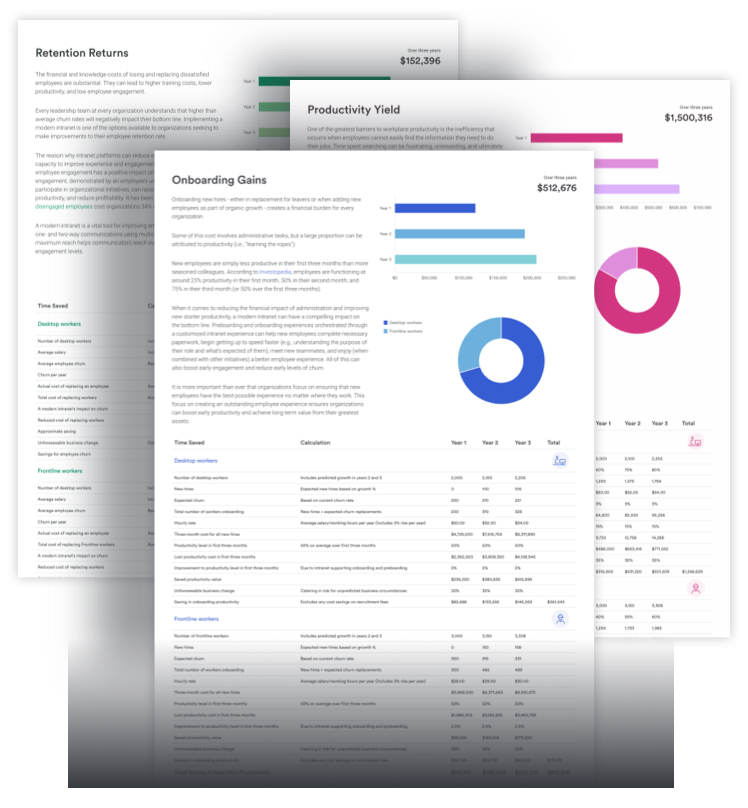Intranet ROI
Calculator
The benefits of intranet software are well known (better employee experience and improved engagement), but the hard financial ROI is also calculable.
Use our simple intranet ROI calculator to see how much money you could save by giving employees fast, comprehensive access to everything they need to do their jobs effectively.
$
£
€
{{currencySymbol}}{{totalRoiOverThreeYearsTotal.toLocaleString()}}
The above figure shows the potential total savings split between Productivity Yield, Onboarding Savings, and Retention Returns. The breakdown of this total is displayed in the full report below. Compare this potential return with Interact’s pricing. Get a quote now

Introduction
In a rapidly changing business environment, organizations are increasingly turning to an ever-wider global talent pool to find, train, and retain employees. Out of all the digital workplace tools available to businesses seeking to create empowered, connected workplaces capable of attracting and keeping these top performers, modern intranets occupy a unique position.
A flexible, innovative intranet puts user needs first and has the power to connect, inform, and engage all global employees. Whether they’re in-office, remote, frontline, or working in any other location, multichannel intranets give workers access to the productivity and communications tools they need.


{{currencySymbol}}{{totalRoiOverThreeYearsTotal.toLocaleString()}}
The above figure shows the potential total savings split between Productivity Yield, Onboarding Savings, and Retention Returns. The breakdown of this total is displayed in the full report below. Compare this potential return with Interact’s pricing. Get a quote now
Introduction
In a rapidly changing business environment, organizations are increasingly turning to an ever-wider global talent pool to find, train, and retain employees. Out of all the digital workplace tools available to businesses seeking to create empowered, connected workplaces capable of attracting and keeping these top performers, modern intranets occupy a unique position.
A flexible, innovative intranet puts user needs first and has the power to connect, inform, and engage all global employees. Whether they’re in-office, remote, frontline, or working in any other location, multichannel intranets give workers access to the productivity and communications tools they need.
Like any other enterprise-grade software, however, the planning and implementation of a modern intranet requires buy-in from senior leaders who clearly understand the returns that their investment will bring.
To demonstrate the potential return on investment (ROI) enterprises may realize by deploying an intranet, we have created this ROI calculator. The purpose of this calculator is to provide you and your decision makers with a financial framework to evaluate the potential financial impact of a new intranet project.
Whether you’re already building a business case, or are just interested to find out the potential ROI of a modern, packaged intranet, our ROI calculator breaks down the returns you may be able to achieve by increasing productivity, decreasing employee attrition, and improving onboarding and training efficiency.



Productivity Yield
One of the greatest barriers to workplace productivity is the inefficiency that occurrs when employees cannot easily find the information they need to do their jobs. Time spent searching can be frustrating, unrewarding, and ultimately result in an increased burden on HR and IT.
To streamline this process, an enterprise search tool can work seamlessly inside an improved intranet experience. When combined with improved content governance controls, advanced search functionality offers long-term business efficiency savings for both desktop and frontline employees.
While the intention of every user is fundamentally the same: namely, to find information that helps them be more productive (e.g., policies and procedures), the positive impact gained through improved search capabilities is not universally constant. Different parts of the workforce access tools and information in different ways, resulting in desktop workers being more reliant on intranets than frontline peers.
Historical observations of desktop workers reveal an average total visit time of less than five minutes per day, typically split into two or three visits. For frontline employees though, this is much less, with some logging in only a few times a week. These differences in access are important for organizations to be aware of because any calculation of ROI depends on a customized view of how that particular organization works.
Regardless of whether it is frontline, desktop, or a mixture of workers who are included, even a small gain in the amount of time saved per employee can have huge repercussions on the associated value of productivity gains. Clearly, organizations will not benefit from 100% of the time saved by each employee (as they may use this in a variety of other ways), but the business will benefit from a proportion of it, and the value of such gains is still significant even when this and other mitigating factors, including macroeconomic risks and realities, are included.
{{currencySymbol}}{{totalValueTimeCapturedTotal.toLocaleString()}}
| Time Saved | Calculation | Year 1 | Year 2 | Year 3 | Total |
|---|---|---|---|---|---|
| Desktop workers |
|
||||
| Number of desktop workers | Includes predicted growth in years 2 and 3 | {{yearOneNumberOfDesktopEmployees.toLocaleString()}} | {{yearTwoNumberOfDesktopEmployees.toLocaleString()}} | {{yearThreeNumberOfDesktopEmployees.toLocaleString()}} | |
| % of active users | Year 1 includes time to onboard & project time. Years 2/3 show intranet maturity | {{percentOfActiveDesktopUsersYearOne}}% | {{percentOfActiveDesktopUsersYearTwo}}% | {{percentOfActiveDesktopUsersYearThree}}% | |
| Number of active users | Number of workers * % of active users | {{numberOfActiveDesktopUsersYearOne.toLocaleString() }} | {{numberOfActiveDesktopUsersYearTwo.toLocaleString() }} | {{numberOfActiveDesktopUsersYearThree.toLocaleString() }} | |
| Hourly rate | Average salary/working hours per year (includes 3% rise per year) | {{currencySymbol}}{{ formatNumber(hourlyRateOfDesktopUserYearOne) }} | {{currencySymbol}}{{ formatNumber(hourlyRateOfDesktopUserYearTwo) }} | {{currencySymbol}}{{ formatNumber(hourlyRateOfDesktopUserYearThree) }} | |
| Average % of time saved p/wk finding information | Interact's expected average saving | {{interactsExpectedDesktopSaving}}% | {{interactsExpectedDesktopSaving}}% | {{interactsExpectedDesktopSaving}}% | |
| Average number of hours saved per year | Working hours p/w * Interact's expected saving * working weeks a year * No of active users | {{ averageNumberOfHoursSavedPerYearYearOne.toLocaleString() }} | {{ averageNumberOfHoursSavedPerYearYearTwo.toLocaleString() }} | {{ averageNumberOfHoursSavedPerYearYearThree.toLocaleString() }} | |
| % of time captured | {{percentOfDesktopTimeCaptured}}% | {{percentOfDesktopTimeCaptured}}% | {{percentOfDesktopTimeCaptured}}% | ||
| Hours captured per year | Average number of hours saved p/y * % of time captured (rounded) | {{hoursCapturedPerYearYearOne.toLocaleString()}} | {{hoursCapturedPerYearYearTwo.toLocaleString() }} | {{hoursCapturedPerYearYearThree.toLocaleString() }} | |
| Value of time captured | Hours captured * hourly rate | {{currencySymbol}}{{ valueOfTimeCapturedYearOne.toLocaleString() }} | {{currencySymbol}}{{ valueOfTimeCapturedYearTwo.toLocaleString() }} | {{currencySymbol}}{{ valueOfTimeCapturedYearThree.toLocaleString() }} | |
| Unforeseeable business change | Catering in risk for unpredicted business circumstances | {{ unforseeableBusinessChange }}% | {{ unforseeableBusinessChange }}% | {{ unforseeableBusinessChange }}% | |
| Adjusted total value of time captured | Adjusted for unforeseeable circumstances | {{currencySymbol}}{{ adjustedDesktopTotalValueOfTimeCapturedYearOne.toLocaleString() }} | {{currencySymbol}}{{ adjustedDesktopTotalValueOfTimeCapturedYearTwo.toLocaleString() }} | {{currencySymbol}}{{ adjustedDesktopTotalValueOfTimeCapturedYearThree.toLocaleString() }} | {{currencySymbol}}{{ adjustedTotalValueOfTimeCapturedTotal.toLocaleString() }} |
| Frontline workers |
|
||||
| Number of frontline workers | Includes predicted growth in years 2 and 3 | {{yearOneNumberOfFrontlineEmployees.toLocaleString() }} | {{yearTwoNumberOfFrontlineEmployees.toLocaleString()}} | {{yearThreeNumberOfFrontlineEmployees.toLocaleString()}} | |
| % of active users | Year 1 includes time to onboard & project time. Years 2/3 show intranet maturity | {{percentOfActiveFrontlineUsersYearOne}}% | {{percentOfActiveFrontlineUsersYearTwo}}% | {{percentOfActiveFrontlineUsersYearThree}}% | |
| Number of active users | Number of workers * % of active users | {{numberOfActiveFrontlineUsersYearOne.toLocaleString() }} | {{numberOfActiveFrontlineUsersYearTwo.toLocaleString() }} | {{numberOfActiveFrontlineUsersYearThree.toLocaleString() }} | |
| Hourly rate | Average salary/working hours per year (includes 3% rise per year) | {{currencySymbol}}{{ formatNumber(hourlyRateOfFrontlineUserYearOne) }} | {{currencySymbol}}{{ formatNumber(hourlyRateOfFrontlineUserYearTwo) }} | {{currencySymbol}}{{ formatNumber(hourlyRateOfFrontlineUserYearThree) }} | |
| Average % of time saved p/wk finding information | Interact's expected average saving | {{interactsExpectedFrontlineSaving}}% | {{interactsExpectedFrontlineSaving}}% | {{interactsExpectedFrontlineSaving}}% | |
| Average number of hours saved per year | Working hours p/w * Interact's expected saving * working weeks a year * No of active users | {{ averageFrontlineNumberOfHoursSavedPerYearYearOne.toLocaleString() }} | {{ averageFrontlineNumberOfHoursSavedPerYearYearTwo.toLocaleString() }} | {{ averageFrontlineNumberOfHoursSavedPerYearYearThree.toLocaleString() }} | |
| % of time captured | {{percentOfFrontlineTimeCaptured}}% | {{percentOfFrontlineTimeCaptured}}% | {{percentOfFrontlineTimeCaptured}}% | ||
| Hours captured per year | Average number of hours saved p/y * % of time captured (rounded) | {{hoursCapturedPerYearFrontlineYearOne.toLocaleString()}} | {{hoursCapturedPerYearFrontlineYearTwo.toLocaleString() }} | {{hoursCapturedPerYearFrontlineYearThree.toLocaleString() }} | |
| Value of time captured | Hours captured * hourly rate | {{currencySymbol}}{{ valueOfTimeCapturedFrontlineYearOne.toLocaleString() }} | {{currencySymbol}}{{ valueOfTimeCapturedFrontlineYearTwo.toLocaleString() }} | {{currencySymbol}}{{ valueOfTimeCapturedFrontlineYearThree.toLocaleString() }} | |
| Unforeseeable business change | Catering in risk for unpredicted business circumstances | {{ unforseeableBusinessChange }}% | {{ unforseeableBusinessChange }}% | {{ unforseeableBusinessChange }}% | |
| Adjusted total value of time captured | Adjusted for unforeseeable circumstances | {{currencySymbol}}{{ adjustedFrontlineTotalValueOfTimeCapturedYearOne.toLocaleString() }} | {{currencySymbol}}{{ adjustedFrontlineTotalValueOfTimeCapturedYearTwo.toLocaleString() }} | {{currencySymbol}}{{ adjustedFrontlineTotalValueOfTimeCapturedYearThree.toLocaleString() }} | {{currencySymbol}}{{ adjustedTotalFrontlineValueOfTimeCapturedTotal.toLocaleString() }} |
| Total Value of Time Captured | {{currencySymbol}}{{totalValueTimeCapturedYearOne.toLocaleString()}} | {{currencySymbol}}{{totalValueTimeCapturedYearTwo.toLocaleString()}} | {{currencySymbol}}{{totalValueTimeCapturedYearThree.toLocaleString()}} | {{currencySymbol}}{{ totalValueTimeCapturedTotal.toLocaleString() }} | |
The model and hypothesis
The model above outlines the calculations for both desktop and frontline workers over a three-year period, with a combined total.
It is assumed that a new intranet experience will offer higher efficiency through upgraded search technology, an overhauled information structure, and overall governance methodology (i.e., removal of outdated content from the current legacy intranet).
Our model suggests that the overall time saved by employees can result in astonishing savings for an organization, even when only a smaller percentage of the time saved by individuals is captured back as usable labor by the organization. In addition to the awareness of this as a reducing factor, our model also takes into account unpredicted future business risks (e.g., macroeconomics, M&A, etc.).
The calculations also take into consideration the expected employee growth rate and combine this with the expected percentage of active users, using the average salary entered in the calculator. For desktop workers, this is a conversative view as active users are often much higher as a proportion of organizational usage.
For frontline workers, the impact is naturally lower due to the nature of roles with less day-to-day reliance on the intranet. This has been factored in with a smaller percentage of active users, time saved in finding information, and saved time captured.
Onboarding Gains
Onboarding new hires - either in replacement for leavers or when adding new employees as part of organic growth - creates a financial burden for every organization.
Some of this cost involves administrative tasks, but a large proportion can be attributed to productivity (i.e., "learning the ropes").
New employees are simply less productive in their first three months than more seasoned colleagues. According to Investopedia, employees are functioning at around 25% productivity in their first month, 50% in their second month, and 75% in their third month (or 50% over the first three months).
When it comes to reducing the financial impact of administration and improving new starter productivity, a modern intranet can have a compelling impact on the bottom line. Preboarding and onboarding experiences orchestrated through a customized intranet experience can help new employees complete necessary paperwork, begin getting up to speed faster (e.g., understanding the purpose of their role and what’s expected of them), meet new teammates, and enjoy (when combined with other initiatives) a better employee experience. All of this can also boost early engagement and reduce early levels of churn.
It is more important than ever that organizations focus on ensuring that new employees have the best possible experience no matter where they work. This focus on creating an outstanding employee experience ensures organizations can boost early productivity and achieve long-term value from their greatest assets.
{{currencySymbol}}{{totalSavingInNewHireProductivityTotal.toLocaleString()}}
| Time Saved | Calculation | Year 1 | Year 2 | Year 3 | Total |
|---|---|---|---|---|---|
| Desktop workers |
|
||||
| Number of desktop workers | Includes predicted growth in years 2 and 3 | {{yearOneNumberOfDesktopEmployees.toLocaleString()}} | {{yearTwoNumberOfDesktopEmployees.toLocaleString()}} | {{yearThreeNumberOfDesktopEmployees.toLocaleString()}} | |
| New hires | Expected new hires based on growth % | {{newDesktopEmployeeHiresYearOne}} | {{newDesktopEmployeeHiresYearTwo}} | {{newDesktopEmployeeHiresYearThree}} | |
| Expected churn | Based on current churn rate | {{expectedDesktopChurnYearOne}} | {{expectedDesktopChurnYearTwo}} | {{expectedDesktopChurnYearThree}} | |
| Total number of workers onboarding | New hires + expected churn replacements | {{totalAmountEmployeesOnboardingYearOne}} | {{totalAmountEmployeesOnboardingYearTwo}} | {{totalAmountEmployeesOnboardingYearThree}} | |
| Hourly rate | Average salary/working hours per year (includes 3% rise per year) | {{currencySymbol}}{{ formatNumber(hourlyRateOfDesktopUserYearOne) }} | {{currencySymbol}}{{ formatNumber(hourlyRateOfDesktopUserYearTwo) }} | {{currencySymbol}}{{ formatNumber(hourlyRateOfDesktopUserYearThree) }} | |
| Three-month cost for all new hires | {{currencySymbol}}{{ threeMonthCostForAllNewHiresYearOne.toLocaleString() }} | {{currencySymbol}}{{ threeMonthCostForAllNewHiresYearTwo.toLocaleString() }} | {{currencySymbol}}{{ threeMonthCostForAllNewHiresYearThree.toLocaleString() }} | ||
| Productivity level in first three months | 50% on average over first three months | {{productivityLevelInFirstThreeMonths}}% | {{productivityLevelInFirstThreeMonths}}% | {{productivityLevelInFirstThreeMonths}}% | |
| Lost productivity cost in first three months | {{currencySymbol}}{{lostProductivityCostYearOne.toLocaleString()}} | {{currencySymbol}}{{lostProductivityCostYearTwo.toLocaleString()}} | {{currencySymbol}}{{lostProductivityCostYearThree.toLocaleString()}} | ||
| Improvement to productivity level in first three months | Due to intranet supporting onboarding and preboarding | {{improvementToDesktopProductivityLevelInFirstThreeMonths}}% | {{improvementToDesktopProductivityLevelInFirstThreeMonths}}% | {{improvementToDesktopProductivityLevelInFirstThreeMonths}}% | |
| Saved productivity value | {{currencySymbol}}{{savedProductivityValueYearOne.toLocaleString()}} | {{currencySymbol}}{{savedProductivityValueYearTwo.toLocaleString()}} | {{currencySymbol}}{{savedProductivityValueYearThree.toLocaleString()}} | ||
| Unforeseeable business change | Catering in risk for unpredicted business circumstances | {{ unforseeableBusinessChange }}% | {{ unforseeableBusinessChange }}% | {{ unforseeableBusinessChange }}% | |
| Saving in onboarding productivity | Excludes any cost savings on recruitment fees | {{currencySymbol}}{{ savingInOnboardingDesktopProductivityYearOne.toLocaleString() }} | {{currencySymbol}}{{ savingInOnboardingDesktopProductivityYearTwo.toLocaleString() }} | {{currencySymbol}}{{ savingInOnboardingDesktopProductivityYearThree.toLocaleString() }} | {{currencySymbol}}{{ savingInOnboardingDesktopProductivityTotal.toLocaleString() }} |
| Frontline workers |
|
||||
| Number of frontline workers | Includes predicted growth in years 2 and 3 | {{yearOneNumberOfFrontlineEmployees.toLocaleString()}} | {{yearTwoNumberOfFrontlineEmployees.toLocaleString()}} | {{yearThreeNumberOfFrontlineEmployees.toLocaleString()}} | |
| New hires | Expected new hires based on growth % | {{newFrontlineEmployeeHiresYearOne}} | {{newFrontlineEmployeeHiresYearTwo}} | {{newFrontlineEmployeeHiresYearThree}} | |
| Expected churn | Based on current churn rate | {{expectedFrontlineChurnYearOne}} | {{expectedFrontlineChurnYearTwo}} | {{expectedFrontlineChurnYearThree}} | |
| Total number of workers onboarding | New hires + expected churn replacements | {{totalAmountFrontlineEmployeesOnboardingYearOne}} | {{totalAmountFrontlineEmployeesOnboardingYearTwo}} | {{totalAmountFrontlineEmployeesOnboardingYearThree}} | |
| Hourly rate | Average salary/working hours per year (includes 3% rise per year) | {{currencySymbol}}{{ formatNumber(hourlyRateOfFrontlineUserYearOne) }} | {{currencySymbol}}{{ formatNumber(hourlyRateOfFrontlineUserYearTwo) }} | {{currencySymbol}}{{ formatNumber(hourlyRateOfFrontlineUserYearThree) }} | |
| Three-month cost for all new hires | {{currencySymbol}}{{ threeMonthCostForAllNewFrontlineHiresYearOne.toLocaleString() }} | {{currencySymbol}}{{ threeMonthCostForAllNewFrontlineHiresYearTwo.toLocaleString() }} | {{currencySymbol}}{{ threeMonthCostForAllNewFrontlineHiresYearThree.toLocaleString() }} | ||
| Productivity level in first three months | 50% on average over first three months | {{productivityLevelInFirstThreeMonths}}% | {{productivityLevelInFirstThreeMonths}}% | {{productivityLevelInFirstThreeMonths}}% | |
| Lost productivity cost in first three months | {{currencySymbol}}{{lostFrontlineProductivityCostYearOne.toLocaleString()}} | {{currencySymbol}}{{lostFrontlineProductivityCostYearTwo.toLocaleString()}} | {{currencySymbol}}{{lostFrontlineProductivityCostYearThree.toLocaleString()}} | ||
| Improvement to productivity level in first three months | Due to intranet supporting onboarding and preboarding | {{improvementToFrontlineProductivityLevelInFirstThreeMonths}}% | {{improvementToFrontlineProductivityLevelInFirstThreeMonths}}% | {{improvementToFrontlineProductivityLevelInFirstThreeMonths}}% | |
| Saved productivity value | {{currencySymbol}}{{savedFrontlineProductivityValueYearOne.toLocaleString()}} | {{currencySymbol}}{{savedFrontlineProductivityValueYearTwo.toLocaleString()}} | {{currencySymbol}}{{savedFrontlineProductivityValueYearThree.toLocaleString()}} | ||
| Unforeseeable business change | Catering in risk for unpredicted business circumstances | {{ unforseeableBusinessChange }}% | {{ unforseeableBusinessChange }}% | {{ unforseeableBusinessChange }}% | |
| Saving in onboarding productivity | Excludes any cost savings on recruitment fees | {{currencySymbol}}{{ savingInOnboardingFrontlineProductivityYearOne.toLocaleString() }} | {{currencySymbol}}{{ savingInOnboardingFrontlineProductivityYearTwo.toLocaleString() }} | {{currencySymbol}}{{ savingInOnboardingFrontlineProductivityYearThree.toLocaleString() }} | {{currencySymbol}}{{ savingInOnboardingFrontlineProductivityTotal.toLocaleString() }} |
| Total Saving in New Hire Productivity | {{currencySymbol}}{{totalSavingInNewHireProductivityYearOne.toLocaleString()}} | {{currencySymbol}}{{totalSavingInNewHireProductivityYearTwo.toLocaleString()}} | {{currencySymbol}}{{totalSavingInNewHireProductivityYearThree.toLocaleString()}} | {{currencySymbol}}{{ totalSavingInNewHireProductivityTotal.toLocaleString() }} | |
The model and hypothesis
The model above reveals the calculations for both desktop and frontline workers over a three-year period, with a combined total.
Using the 50% productivity variable over the first three months, combined with an hourly rate, an initial figure is produced illustrating the potential lost productivity due to no intranet or a poorly performing system.
A modern intranet can have a small percentage impact on improving this productivity level through better preboarding and onboarding experiences. This is higher for desktop workers than for frontline staff as desktop are likely to save a greater proportion of their working hours.
Of the percentage of productivity potentially gained by individuals through saved time, the model accounts for the reality that only a smaller percentage again will actually be captured by the organization in terms of improved productivity. Again, this percentage is higher for desktop workers than for frontline.
Finally, as with productivity, there will always be macroeconomics at play which reduce the saving further. These are considered in our model as unforeseeable business change.
Retention Returns
The financial and knowledge-costs of losing and replacing dissatisfied employees are substantial. They can lead to higher training costs, lower productivity, and low employee engagement.
Every leadership team at every organization understands that higher than average churn rates will negatively impact their bottom line. Implementing a modern intranet is one of the options available to organizations seeking to make improvements to their employee retention rate.
The reason why intranet platforms can reduce employee attrition lies in their capacity to improve experience and engagement. It is widely understood that employee engagement has a positive impact on retention because lower engagement, demonstrated by an employee’s unwillingness to voluntarily participate in organizational initiatives, can raise absenteeism, lower productivity, and reduce profitability. It has been suggested that actively disengaged employees cost organizations 34% of their salaries.
A modern intranet is a vital tool for improving employee engagement. Improved one- and two-way communications using multichannel messaging for maximum reach helps communicators reach every employee and boost engagement levels.
{{currencySymbol}}{{totalSavingForNewEmployeeChurnTotal.toLocaleString()}}
| Time Saved | Calculation | Year 1 | Year 2 | Year 3 | Total |
|---|---|---|---|---|---|
| Desktop workers |
|
||||
| Number of desktop workers | Includes predicted growth in years 2 and 3 | {{yearOneNumberOfDesktopEmployees.toLocaleString()}} | {{yearTwoNumberOfDesktopEmployees.toLocaleString()}} | {{yearThreeNumberOfDesktopEmployees.toLocaleString()}} | |
| Average salary | Includes an average of 3% rise per year | {{currencySymbol}}{{averageDesktopSalaryYearOne.toLocaleString()}} | {{currencySymbol}}{{averageDesktopSalaryYearTwo.toLocaleString()}} | {{currencySymbol}}{{averageDesktopSalaryYearThree.toLocaleString()}} | |
| Average employee churn | Based on current churn rate | {{inputVals.estimatedYearlyChurn}}% | {{inputVals.estimatedYearlyChurn}}% | {{inputVals.estimatedYearlyChurn}}% | |
| Churn per year | {{retentionExpectedDesktopChurnYearOne}} | {{retentionExpectedDesktopChurnYearTwo}} | {{retentionExpectedDesktopChurnYearThree}} | ||
| Actual cost of replacing an employee | Assumed lower than up to one third estimate of employee's salary | {{actualCostOfReplacingDesktopEmployee}}% | {{actualCostOfReplacingDesktopEmployee}}% | {{actualCostOfReplacingDesktopEmployee}}% | |
| Total cost of replacing workers | Average salary/working hours per year (includes 3% rise per year) | {{currencySymbol}}{{totalCostOfReplacingEmployeesYearOne.toLocaleString()}} | {{currencySymbol}}{{totalCostOfReplacingEmployeesYearTwo.toLocaleString()}} | {{currencySymbol}}{{totalCostOfReplacingEmployeesYearThree.toLocaleString()}} | |
| A modern intranet's impact on churn | {{modernIntranetsImpactOnChurnDesktop}}% | {{modernIntranetsImpactOnChurnDesktop}}% | {{modernIntranetsImpactOnChurnDesktop}}% | ||
| Reduced cost of replacing workers | {{currencySymbol}}{{reducedCostOfReplacingEmployeesYearOne.toLocaleString()}} | {{currencySymbol}}{{reducedCostOfReplacingEmployeesYearTwo.toLocaleString()}} | {{currencySymbol}}{{reducedCostOfReplacingEmployeesYearThree.toLocaleString()}} | ||
| Approximate saving | {{currencySymbol}}{{approximateSavingDesktopYearOne.toLocaleString()}} | {{currencySymbol}}{{approximateSavingDesktopYearTwo.toLocaleString()}} | {{currencySymbol}}{{approximateSavingDesktopYearThree.toLocaleString()}} | ||
| Unforeseeable business change | Catering in risk for unpredicted business circumstances | {{unforseeableBusinessChange}}% | {{unforseeableBusinessChange}}% | {{unforseeableBusinessChange}}% | |
| Savings for employee churn | {{currencySymbol}}{{savingsForEmployeeChurnDesktopYearOne.toLocaleString()}} | {{currencySymbol}}{{savingsForEmployeeChurnDesktopYearTwo.toLocaleString()}} | {{currencySymbol}}{{savingsForEmployeeChurnDesktopYearThree.toLocaleString()}} | {{currencySymbol}}{{savingsForEmployeeChurnDesktopTotal.toLocaleString()}} | |
| Frontline workers |
|
||||
| Number of desktop workers | Includes predicted growth in years 2 and 3 | {{yearOneNumberOfFrontlineEmployees.toLocaleString()}} | {{yearTwoNumberOfFrontlineEmployees.toLocaleString()}} | {{yearThreeNumberOfFrontlineEmployees.toLocaleString()}} | |
| Average salary | Includes an average of 3% rise per year | {{currencySymbol}}{{averageFrontlineSalaryYearOne.toLocaleString()}} | {{currencySymbol}}{{averageFrontlineSalaryYearTwo.toLocaleString()}} | {{currencySymbol}}{{averageFrontlineSalaryYearThree.toLocaleString()}} | |
| Average employee churn | Based on current churn rate | {{inputVals.estimatedYearlyChurn}}% | {{inputVals.estimatedYearlyChurn}}% | {{inputVals.estimatedYearlyChurn}}% | |
| Churn per year | {{retentionExpectedFrontlineChurnYearOne}} | {{retentionExpectedFrontlineChurnYearTwo}} | {{retentionExpectedFrontlineChurnYearThree}} | ||
| Actual cost of replacing an employee | Assumed lower than up to one third estimate of employee's salary | {{actualCostOfReplacingFrontlineEmployee}}% | {{actualCostOfReplacingFrontlineEmployee}}% | {{actualCostOfReplacingFrontlineEmployee}}% | |
| Total cost of replacing Frontline workers | Average salary/working hours per year (includes 3% rise per year) | {{currencySymbol}}{{totalCostOfReplacingFrontlineEmployeesYearOne.toLocaleString()}} | {{currencySymbol}}{{totalCostOfReplacingFrontlineEmployeesYearTwo.toLocaleString()}} | {{currencySymbol}}{{totalCostOfReplacingFrontlineEmployeesYearThree.toLocaleString()}} | |
| A modern intranet's impact on churn | {{modernIntranetsImpactOnChurnFrontline}}% | {{modernIntranetsImpactOnChurnFrontline}}% | {{modernIntranetsImpactOnChurnFrontline}}% | ||
| Reduced cost of replacing workers | {{currencySymbol}}{{reducedCostOfReplacingFrontlineEmployeesYearOne.toLocaleString()}} | {{currencySymbol}}{{reducedCostOfReplacingFrontlineEmployeesYearTwo.toLocaleString()}} | {{currencySymbol}}{{reducedCostOfReplacingFrontlineEmployeesYearThree.toLocaleString()}} | ||
| Approximate saving | {{currencySymbol}}{{approximateFrontlineSavingYearOne.toLocaleString()}} | {{currencySymbol}}{{approximateFrontlineSavingYearTwo.toLocaleString()}} | {{currencySymbol}}{{approximateFrontlineSavingYearThree.toLocaleString()}} | ||
| Unforeseeable business change | Catering in risk for unpredicted business circumstances | {{unforseeableBusinessChange}}% | {{unforseeableBusinessChange}}% | {{unforseeableBusinessChange}}% | |
| Savings for employee churn | {{currencySymbol}}{{savingsForEmployeeChurnFrontlineYearOne.toLocaleString()}} | {{currencySymbol}}{{savingsForEmployeeChurnFrontlineYearTwo.toLocaleString()}} | {{currencySymbol}}{{savingsForEmployeeChurnFrontlineYearThree.toLocaleString()}} | {{currencySymbol}}{{savingsForEmployeeChurnFrontlineTotal.toLocaleString()}} | |
| Total saving for Employee Churn | {{currencySymbol}}{{totalSavingForNewEmployeeChurnYearOne.toLocaleString()}} | {{currencySymbol}}{{totalSavingForNewEmployeeChurnYearTwo.toLocaleString()}} | {{currencySymbol}}{{totalSavingForNewEmployeeChurnYearThree.toLocaleString()}} | {{currencySymbol}}{{totalSavingForNewEmployeeChurnTotal.toLocaleString()}} | |
The model and hypothesis
The model above reveals the calculations for both desktop and frontline workers over a three-year period, with a combined total.
It uses the churn rate entered vs the current number of employees (with growth in years 2 and 3) to calculate the number of employees leaving an organization. Using the average salary entered (for both desktop and frontline), combined with a conservative cost of replacing an employee (20% for desktop and 15% for frontline rather than the 33% quoted by some sources), a total cost for replacements is calculated.
A modern intranet can have a small but still significant impact on churn. Inevitably, the impact percentage is higher for desktop employees than for frontline counterparts as desktop workers utilize intranet software more regularly.
Finally, as with the other models, there will always be uncontrollable macroeconomic factors which reduce the saving further. This is shown as unforeseeable business change.
Disclaimer
Interact Software provides this ROI calculator in good faith to help in the analysis of potential cost savings when purchasing and utilizing intranet software. Data provided for the calculation is the user's responsibility. We do not make any representations or warranties of any kind on the information provided. We also disclaim any liability or responsibility for the accuracy, correctness, or completeness of any information provided. Your results may vary from those provided by the ROI calculator.
